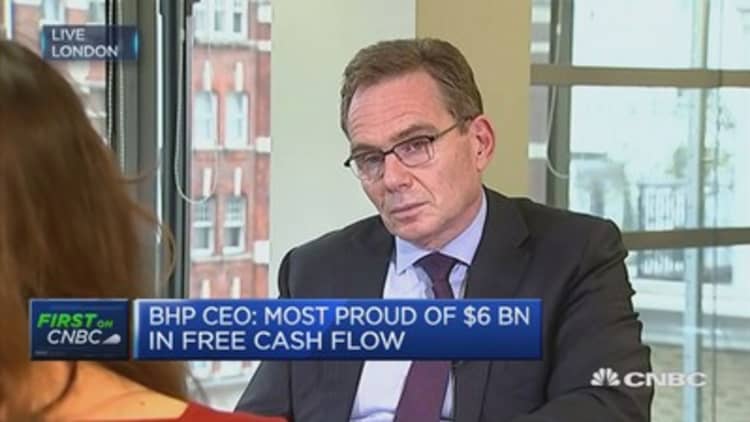When iron ore futures on the Dalian Commodity Exchange (DCE) surged to a record high last week on expectations about Beijing's infrastructure plans, spot prices in Australia jumped soon after.
This pattern demonstrates China's growing clout in commodity price setting — even when analysis of the market says price should move in the opposite direction.
Prices of the steel-making material have since come off, but China-originating global price gyrations underscore how far the country has come in pricing power on both the spot and in the futures market, particularly for heavily-traded products like copper, which is regarded as a barometer of economic health.
"Over the last two years, the drivers of global metal price discovery have, in our view, shifted to the East," Citi analysts wrote in a report on Feb. 19.
As the largest consumer of a range of commodities from iron ore to soybeans, China has long sought to be the price-maker, rather than a price-taker, for the raw materials it needs. To facilitate its entry into a greater role in price discovery, commodity exchanges, such as the Shanghai Futures Exchange (SHFE) and the DCE were set up in the 1990s.
[China] is facing the chance of a lifetime to become a global pricing center for commodities.Fang XinghaiChina Securities Regulatory Commission Vice Chairman, in 2016
As recently as May 2016, the vice chairman of the China Securities Regulatory Commission, Fang Xinghai, reiterated the Asian giant's ambition to call the shots in commodities pricing even as he underscored fierce competition for the position, according to various media reports.
However, China's role as a price-maker has been elusive as volatility in its tumultuous markets across a range of commodities was attributed to excessive speculation, particularly by the large number of individual retail investors. A commodity financing scandal in 2014 also hit overall confidence.
Still, there's no stopping China as trading volumes in the mostly actively traded SHFE copper contract have increased nearly 50 percent in the last six years. Now, SHFE copper trade volumes have outstripped those on the traditional global bellwether, the London Metal Exchange.

In Shanghai, the average daily turnover in the most actively traded copper contract was about 3.02 million tons in 2016, Citi noted. In contrast, average turnover of the most actively traded copper contract on the LME in 2016 was equivalent to around 1.5 million tons of copper per day.
While investors are aware that price swings in Chinese futures are often magnified due to the sheer amount of trades going on daily, they are unable to completely shut the noise out due to the inevitable spillover into international markets.
"China is playing a more and more important role in the futures trade. So far, the Chinese traders tend to be more short term-oriented and quite 'speculative," trader and president of Lin Asset Management, Chen Lin, told CNBC. "A lot of traders in the U.S. hate it, but it is the global trend, as China is the number-one consumer of many of these metals."
However, there are limitations and flaws to SHFE's lead in pricing that are worrying the market, and its activity appears to be based primarily on speculation rather than supply-demand dynamics.
"The LME copper market has good levels of liquidity at least two years forward, while in contrast, the SHFE copper market has little contract liquidity further forward than about three months," Citi analysts wrote.
This is evidenced by the turnover of the most actively traded contact on each exchange. On the SHFE, the benchmark contract accounts for the most of the turnover, while that on the LME accounts for just 40 percent, the house added. This lack of depth in Shanghai's trading activity makes it challenging for investors to hedge their trades.
There are other difficulties. For now, trading on Chinese commodity exchanges is still encumbered by a lack of foreign exchange convertibility and limited foreign participation due to regulations.
"The SHFE market remains very short term and local in focus, but with an increasing spillover onto levels of global volatility," Citi added.
"This has perhaps been the most striking feature of Chinese futures markets, rather than the impact on price determination per se."

While Chinese exchanges have tried to stem price swings attributed to speculators using margin hikes or increasing transaction fees, volumes are likely to grow with activity and liquidity moving ahead in the forward pricing curve, Citi said.
China has signaled that it's aware of the challenges it faces in becoming the definitive — not just the loudest — voice in the room.
"[China] is facing the chance of a lifetime to become a global pricing center for commodities ," Fang said at the SHFE's annual conference last May, as reported by various media outlets, adding it would be a "historic mistake" not to grasp the rare opportunity. He also pledged the country's commitment to opening up the market to foreign investors.
Still, he said, China shouldn't underestimate the determination of current pricing centers to maintain their status.
"There is no doubt that as Chinese commodities exchanges grow and become more mature, their contracts will have a bigger role in global price discovery. However, if China's financial markets remain relatively closed, their influence on the global market will be limited no matter how large their trading volumes can be," said Yvonne Li, a commodity analyst at CPM Group in New York.
"From my own experience, I still look at LME as the main gauge of market activity; I see SHFE as an indicator for market sentiment," she added.

